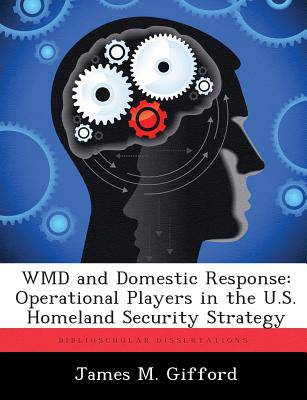
- Afhalen na 1 uur in een winkel met voorraad
- Gratis thuislevering in België vanaf € 30
- Ruim aanbod met 7 miljoen producten
- Afhalen na 1 uur in een winkel met voorraad
- Gratis thuislevering in België vanaf € 30
- Ruim aanbod met 7 miljoen producten
Zoeken
WMD and Domestic Response
Operational Players in the U.S. Homeland Security Strategy
James M Gifford
Paperback | Engels
€ 54,45
+ 108 punten
Omschrijving
America's first line of defense in the aftermath of any terrorist attack is its first responder community -- police officers, firefighters, emergency medical providers, public works personnel, and emergency management officials. Almost 11 million state and local first responders regularly risk their lives in the line of duty to save the lives of others and make the country safer and more secure. These individuals include specially trained hazardous materials teams, collapse search and rescue units, bomb squads, and tactical units.79 It is the readiness and capabilities of these public servants that determine whether the U.S. can actually deal with the consequences of a domestic WMD attack or not. Currently, there are simply not enough properly equipped and trained first responders to protect all the towns and cities of the U.S. But how much is enough? According to Fireman and HAZMAT expert Alex MacDonald, a well prepared city would possess an adequate number of first responders to consequence manage a WMD event when it could simultaneously triage large numbers of casualties (in excess of 3,500), fight associated fires, perform search and rescue functions, and initiate HAZMAT procedures, while maintaining the ability to respond to secondary emergency requirements.80 Obviously, to create such a first responder capability in every major town and city is currently beyond the economic and political reach of the U.S.
Specificaties
Betrokkenen
- Auteur(s):
- Uitgeverij:
Inhoud
- Aantal bladzijden:
- 40
- Taal:
- Engels
Eigenschappen
- Productcode (EAN):
- 9781288409082
- Verschijningsdatum:
- 6/12/2012
- Uitvoering:
- Paperback
- Formaat:
- Trade paperback (VS)
- Afmetingen:
- 189 mm x 246 mm
- Gewicht:
- 90 g

Alleen bij Standaard Boekhandel
+ 108 punten op je klantenkaart van Standaard Boekhandel
Beoordelingen
We publiceren alleen reviews die voldoen aan de voorwaarden voor reviews. Bekijk onze voorwaarden voor reviews.











